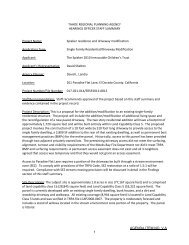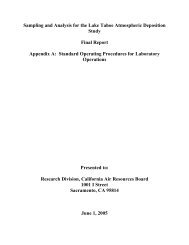FEIS - Tahoe Regional Planning Agency
FEIS - Tahoe Regional Planning Agency
FEIS - Tahoe Regional Planning Agency
You also want an ePaper? Increase the reach of your titles
YUMPU automatically turns print PDFs into web optimized ePapers that Google loves.
RESPONSE TO COMMENTS ON THE DEIS<br />
B o u l d e r B a y C o m m u n i t y E n h a n c e m e n t P r o g r a m P r o j e c t E I S<br />
should erosion occur. e) The parameters monitored will be finalized during project<br />
permitting. The parameters listed are recommended as typical water quality<br />
constituents for stormwater monitoring programs.<br />
Comment 335-y: Comment Summary - Describe storm water, TMDL, bio-retention, and fine sediment<br />
monitoring techniques, length of time, and compliance standards, adaptive strategies,<br />
and monitoring report process.<br />
a) The DEIS makes recommendations, but TRPA as the lead agency reserves the<br />
regulatory ability to amend these recommendations. Given that no codified regulation<br />
by TRPA or NDEP currently requires the monitoring of fine sediments nor are<br />
standardized protocols agreed upon at this time, the Project commits to monitoring of<br />
fine sediments as specified by TRPA or future TMDL directives for the Lake <strong>Tahoe</strong><br />
Basin. b) The duration of post-project monitoring will be determined during project<br />
permitting. The Project is required to meet TRPA discharge limits listed in Table 4.3-<br />
2. c) Alternatives C and D will be required to meet TRPA discharge standards. Net<br />
gain is determined by comparing the total volume of runoff and the associated load<br />
potentially carried by that runoff. See Appendix AB for a comparison of the project<br />
area with treatments sized to capture the 20yr/1hr storm total runoff volume as<br />
compared to the 100yr/1hr storm total runoff volume. d) In reference to Alternatives<br />
C and D, the stormwater treatment systems will capture and infiltrate up to the<br />
100yr/1hr storm total runoff volume, including the "first flush". The stormwater<br />
monitoring program will be developed based on the selected Alternative. The DEIS<br />
does not state that grab sampling is inadequate for monitoring, the DEIS clarifies that<br />
the results and conclusions are based on 6 storms, which is a small sample size. The<br />
supplemental analysis included in Appendix AB incorporates an additional 12 storm<br />
events (DRI) in addition to the 6 storms sampled during pre-project monitoring to<br />
characterize existing conditions for the project area. Automated samplers will be<br />
employed if determined by TRPA to be appropriate during project permitting. e)<br />
Boulder Bay will be responsible for implementing "adaptive strategies" if determined<br />
necessary by post-project monitoring results. f) The post-project monitoring program<br />
will be developed during permitting of the selected Alternative. Yes, monitoring will<br />
measure the success of the Project. g) The duration of post-project monitoring will be<br />
determined by TRPA, the regulatory agency, during permitting of the selected<br />
Alternative. Monitoring reports will be available for review by the public as part of<br />
public project file.<br />
Comment 335-z: Comment Summary - App. G needs to support calculations, underlying assumptions.<br />
See DEIS Appendix G and Table 1 of Appendix AB. The calculations are presented<br />
in table format with reduction assumptions clearly presented. The supplemental<br />
surface water quality analysis presented in Appendix AB models existing conditions,<br />
E20, C20 and C100 (please see response to comment 79-g for terms defined) for<br />
analysis of the project area under a variety of water year conditions.<br />
Comment 335-aa: Comment Summary - In App. G, what is meant by a BMP contributing area? Clarify<br />
table assumptions and definitions underlying the calculations.<br />
The purpose of the calculations are to disclose the total contributing area and the<br />
calculations made to reduce the volume of runoff from these contributing areas.<br />
DEIS Appendix G presents the basic components used to design the stormwater<br />
treatment systems and are presented in the DEIS as supporting calculations for the<br />
summary tables (Tables 4.3-8 through 4.3-12) presented for the impact HYDRO-3<br />
analysis. Table 1 added in Appendix AB further details these calculations for the<br />
SEPTEMBER 8 , 2010 HAUGE BRUECK ASSOCIATES PAGE 8- 149






